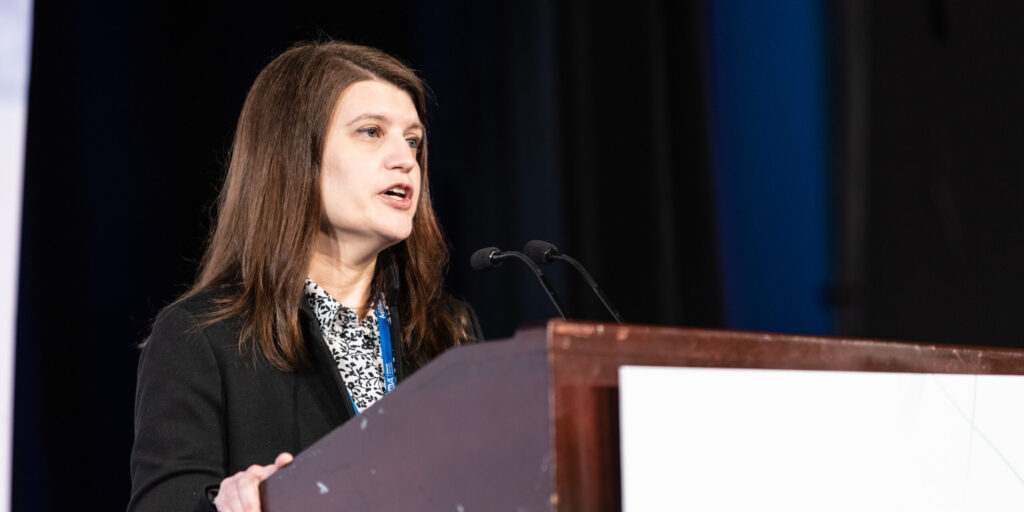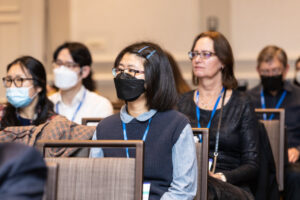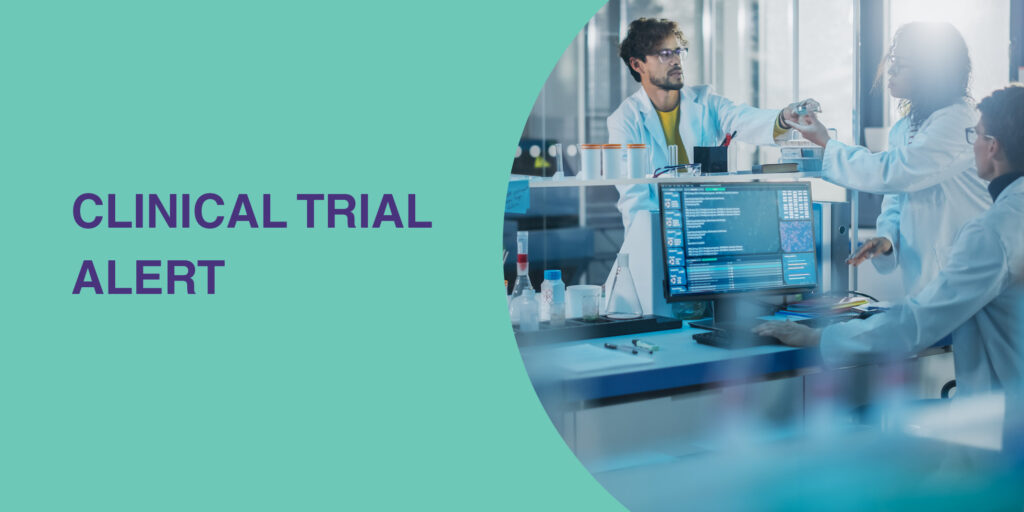
2022 Clinical & Scientific Conference: March 16 Highlights
By Sujatha Gurunathan | Wednesday, March 16, 2022
Today is the last day of 2022 MDA’s Clinical & Scientific Conference. The theme for today is clinical trials in neuromuscular disease (NMD)!
Highlights
Best poster winners
At the Highlight Session at the end of the day, two awards were presented for outstanding poster presentations.
PhD candidate Sarah Holbrook from the Jackson Laboratory at the University of Maine was recognized for her poster entitled:
AAV9-IGHMBP2 GENE THERAPY SIGNIFICANTLY IMPROVES MOTOR PERFORMANCE IN SEVERE SMARD1-LIKE MOUSE MODEL, NMDEM3, AND CMT2S MOUSE MODEL, NMDEM5
Postdoctoral scientist Pamela Barraza-Flores, PhD, and colleagues, from the Beggs Laboratory at Boston Children’s Hospital at Harvard Medical School, were recognized for the poster:
ZEBRAFISH AND CELLULAR MODELS OF SELENON-RELATED MYOPATHY EXHIBIT EARLY GROWTH AND METABOLIC ABNORMALITIES
Clinical trial outcomes
During the clinical trial outcomes session, 14 researchers from academia and industry presented findings from recent or ongoing clinical studies. The US Food and Drug Administration (FDA)’s overview of clinical research can provide context for understanding the studies presented today. Preclinical studies test the effects of an investigational drug in the laboratory using cell or animal models, while clinical trials test the effects of the investigational drug in people. The typical stages of a clinical trial are:
Phase 1
- 20-100 study participants (often less in rare diseases)
- Several months in length
Phase 2
- Up to several hundred study participants
- Several months to 2 years in length
Phase 3
- 300-3,000 study participants
- 1- 4 years in length
Phase 4
- Several thousand study participants
Nusinersen effect in presymptomatic infants with SMA
Nusinersen was approved by the FDA in 2016 for the treatment of children and adults with spinal muscular atrophy (SMA). Thomas Crawford, MD of Johns Hopkins Medicine presented interim findings (at 4.9 years) from the ongoing, phase 2, open-label, multinational 8-year NUTURE study to test effects of nusinersen administration in infants with SMA before they show symptoms. In this study, nusinersen was well tolerated, with no new safety concerns identified. All children are still alive and able to walk alone, 84% have never had any respiratory events, and none are on ventilation.
Efficacy and safety of risdiplam in people with types 2 and 3 SMA

Risdiplam was approved by the FDA in Aug. 2020 for the treatment of SMA in patients 2 months of age and older. John Day, MD, PhD of Stanford University spoke of the phase 3, randomized, placebo-controlled, double-blind SUNFISH study. This study had broad inclusion criteria, including participants aged 2-25 years and several categories of non-ambulatory participants with type 2 or type 3 SMA. Treatment with risdiplam did not result in severe adverse events. Risdiplam-treated participants demonstrated improvements in motor function and disease stabilization that were maintained over the three-year study period, as measured by a number of different metrics (MFM32, RULM, HFMSE, SMAIS–ULM).
Efficacy and safety of long-term avalglucosidase alfa treatment in people with LOPD Pompe disease The enzyme replacement therapy (ERT), alglucosidase alfa, was approved in 2006 to treat people with Pompe disease and has been the standard of care for ~15 years. A new ERT option, avalglucosidase alfa, received FDA approval in August 2021. Hani Kushlaf, MD, from the University of Cincinnati, presented findings from the ongoing, phase 3, randomized, multinational COMET trial of avalglucosidase alfa in participants (age 3 years or older) with late-onset Pompe disease (LOPD). This trial compared the efficacy, after 97 weeks of treatment, of avalglucosidase alfa with alglucosidase alfa. The two compounds showed a similar safety profile, but avalglucosidase alfa treatment resulted in improvements in respiratory function, motor function, and health-related quality of life measures in comparison to treatment with alglucosidase alfa.
Safety and efficacy of gene therapy in people with LOPD
Currently, ERT to treat people with Pompe disease requires infusions of the GAA enzyme every two weeks. Edward Smith, MD, from Boston Children’s Hospital, spoke about an investigational gene therapy AAV8-LSPhAA (ACTUS-101) that is designed to introduce a copy of the GAA gene into the liver, and has the potential to be a single dose therapy that corrects the underlying defect in Pompe disease. This gene therapy strategy was effective in a preclinical model. In a phase 1 study, participants received a single infusion of the therapy and were followed for five years. Treatment resulted in increased GAA enzyme in muscles and in the blood. Common adverse events included headache at dosing, myalgia, and some markers of liver damage. Some severe adverse events were also recorded. The next step for the research team is evaluation of the dose of the gene therapy to increase efficacy.
Efficacy and safety of ravulizumab in people with anti-AChR ab+ MGTuan Vu, MD of University South Florida presented findings from the phase 3, randomized, placebo-controlled, double-blind, multinational CHAMPION study to test effects of ravulizumab (an inhibitor of the C5 complement protein) in people with anti-AChR antibody (ab)+ myasthenia gravis (MG). The blinded treatment period lasted for 26-weeks, and then all participants received access to the drug in an open-label extension period. Ravulizumab had a good safety profile in the study, and treatment with the drug resulted in rapid and sustained improvements in function (MG-ADL and MG-QMG scores) and health-related quality of life measures (MG-QOL15r and Neuro-QoL Fatigue).
Efficacy of omaveloxolone in people with Friedreich’s ataxia
S.H. Subramony, MD, from the University of Florida Health, presented the findings of the phase 2, randomized, placebo-controlled, double-blind, multinational MOXIe study of omaveloxolone (omav) to treat people with Friedreich’s ataxia (FA). Omav was well-tolerated with an adverse event profile similar to earlier studies. Treatment with omav improved disease symptoms, as assessed by the mFARS scale commonly used to measure disease progression in FA.
Comparison of vamorolone and prednisone effects in people with DMD
Steroids, such as prednisone, are the standard of care in Duchenne muscular dystrophy (DMD), but long-term use can result in side effects such as weight gain and bone weakness/growth effects. Vamorolone is a “dissociative steroid” that provides the benefits of steroid treatment, but with potentially fewer side effects. Paula Clemens, MD, from the University of Pittsburgh, presented findings from the phase 2, randomized, placebo-controlled, double-blind VISION-DMD study, which compared effects of vamarolone with those of prednisone over a 24 week treatment period. Vamaralone treatment resulted in similar improvements on five functional measures (TTSTAND, 6MWT, TTRW, etc.) to prednisone treatment, but unlike prednisone, did not decrease the growth trajectory of participants. Vamarolone also produced fewer adverse events, as defined by the study investigators.
Early-stage study of EDG-5506 in boys with BMD
Joanne Donovan, MD, PhD, of Edgewise Therapeutics, spoke about a phase 1b clinical trial studying the investigational drug EDG-5506 in people with Becker muscular dystrophy (BMD). EDG-5506 is a selective inhibitor of fast muscle fiber myosin, and treatment with EDG-5506 is expected to reverse muscle damage and injury that results from the lack of dystrophin in people with BMD and DMD. In the phase 1b study, EDG-5506 was well-tolerated in participants with BMD, with only mild adverse events. Though treatment did not affect hand-grip strength, it did reduce biomarkers of muscle damage and injury, as well as BMD-related biomarkers. The Edgewise team plans to initiate a phase 2 clinical trial in people with BMD this year, with a trial in people with DMD to follow.
Study of SRP-5051 to treat people with DMD amenable to exon 51 skipping

Darko Stevanovic, of Sarepta Therapeutics, presented results from the phase 2, open-label MOMENTUM trial to test the effects of increasing doses of SRP-5051 for treatment of people with DMD. People with DMD lack dystrophin protein. SRP-5051 is designed to enter cells and skip mutations in exon 51 of the DMD gene to allow production of the dystrophin protein. In part A of this study, participants receiving SRP-5051 experienced only mild to moderate adverse events. More than 10% of participants experienced hypomagnesemia (reduced magnesium levels) and nausea; in all cases, the hypomagnesemia was resolved by magnesium supplementation. The level of skipping over exon 51 and the production of dystrophin were monitored at 12 weeks, and were significantly increased with higher doses of treatment. The dystrophin protein was also found to be localized to the correct part of the muscle (sarcolemma). All participants in part A of the study were invited to enroll in part B, which is currently enrolling.
Safety and functional outcomes from systemic SGCB gene transfer in people with LGMD2E/R4
Louise Rodino-Klapac, PhD, of Sarepta Therapeutics, presented interim results from an open-label, phase 1/2 study of the investigational gene therapy SRP-9003 for treatment of people with limb girdle muscular dystrophy 2E/R4 (LGMD 2E/R4). This gene therapy is designed to introduce the SGCB gene into skeletal and cardiac muscle, correcting the underlying defect in LGMD 2E/R4. Low dose and high dose treatment with SRP-9003 lead to clinically meaningful functional improvements in participants over the 2 to 3 year study period, and appeared to correct molecular defects caused by the lack of SGCB (i.e., sarcoglycan complex formation). The drug exhibited a good safety profile, with mild to moderate adverse events (e.g., vomiting, increased markers of tissue damage, etc.) that were manageable and transient.
Study of CNM-Au8 to slow disease progression in people with ALS
Robert Glanzman, MD, FAAN, of CLENE Nanomedicine, presented results from the phase 2, randomized, double-blind, placebo-controlled RESCUE-ALS study of the investigational therapy CNM-Au8 to slow disease progression in people with amyotrophic lateral sclerosis (ALS). CNM-Au8 is a suspension of nanocrystalline gold that is expected to increase energy production in neurons and protect them from oxidative stress. Treatment with CNM-Au8 did not produce serious adverse events in participants. After 36-weeks of treatment, CNM-Au8-treated participants showed significant improvements in functional measures (ALSFRS-R), quality of life measures and survival. The trial, however, did not meet its primary endpoint of higher Motor Unit Number Index (MUNIX) score, which measures the number, function, and health of motor neurons.
Study of ifetroban to prevent cardiomyopathy associated with DMD
Ines Macias-Perez, PhD, of Cumberland Pharmaceuticals, spoke about preclinical studies testing the ability of the compound ifetroban (a thromboxane receptor antagonist) to reverse damaging changes that occur in the heart and lungs in the context of DMD/BMD. These studies were funded by FIGHT DMD, an advocacy foundation established by a family personally affected by the disease. In several different mouse models of DMD, daily, oral administration of ifetroban protected the mice against inflammatory and fibrotic changes in the heart and reduced heart dysfunction. Based on these studies, the Cumberland team is initiating the phase 2 randomized, double-blind, placebo-controlled FIGHT DMD trial to study the safety, efficacy, and correct dosage of ifetroban to treat early and advanced stage cardiomyopathy in 48 boys with DMD.
Study of losmapimod in people with FSHD
Rabi Tawil, MD, of the University of Rocheser Medical Center, presented findings from the phase 2, randomized, double-blind, placebo-controlled, 48-week ReDUX4 study of losmapimod (a selective p38α/β MAPK inhibitor) in people with facioscapulohumeral muscular dystrophy (FSHD). Though the study was small and did not meet its primary endpoints, multiple metrics indicated a slowing of disease progression or improvement of function in treated participants. Based on this data, the research team plans to initiate a phase 3 clinical trial later this year.
Long-term follow-up of cipaglucosidase alfa/miglustat treatment in ambulatory people with Pompe disease
Some people with Pompe disease do not respond to existing ERT. Barry Byrne, MD, PhD, of the University of Florida Health presented the findings of the ongoing, open-label, multinational phase 1/2 study of cipalglucosidase alfa + miglustat as an alternative treatment in ambulatory people with Pompe disease. The participants in this study were divided into cohorts to reflect their previous exposure to ERT and other features. Participants who had previously received ERT demonstrated improvements in motor function and stabilized respiratory function after treatment with cipalglucosidase alfa + miglustat, while ERT naïve participants demonstrated significant improvements in both measures on this treatment. In both cohorts, treatment resulted in stable or decreased biomarkers of disease. Most adverse events were mild to moderate, and similar to the what was previously seen with alglucosidase alfa treatment.
The 2023 MDA Clinical and Scientific Conference will take place in Dallas, TX, from March 16-19, 2023. Mark your calendar now and look out for updates this fall!
TAGS: Clinical Trials, Drug Development, Exon Skipping, Healthcare, Innovation, MDA Clinical and Scientific Conference
TYPE: Blog Post
Disclaimer: No content on this site should ever be used as a substitute for direct medical advice from your doctor or other qualified clinician.




